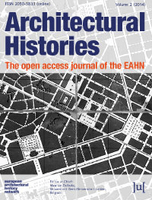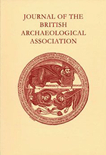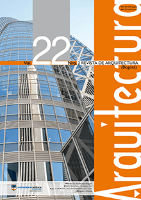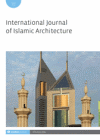
Architectural Histories
Scope & Guideline
Innovative Insights into Architectural Heritage
Introduction
Aims and Scopes
- Interdisciplinary Approaches to Architectural History:
The journal promotes the integration of various disciplines such as sociology, anthropology, and cultural studies into architectural history, allowing for a richer understanding of architectural practices and their societal implications. - Global Perspectives on Architecture:
Architectural Histories emphasizes a global outlook, examining architectural developments in diverse geographical contexts, from colonial impacts to contemporary practices in different cultures. - Critical Examination of Architectural Ideologies:
The focus includes a critical analysis of architectural ideologies, exploring how these ideologies reflect and shape cultural, political, and social realities. - Engagement with Contemporary Issues:
The journal addresses contemporary issues in architecture, including sustainability, urbanism, and the impact of technology on architectural practices. - Historical Reassessments and Reinterpretations:
A core aim is to revisit and reinterpret historical architectural narratives, challenging established perspectives and uncovering overlooked contributions from various cultural contexts.
Trending and Emerging
- Architectural Responses to Social Issues:
Recent publications highlight architecture's engagement with social issues, such as disability, urban renewal, and postcolonial critiques, reflecting a growing interest in how architecture can address pressing societal challenges. - Reevaluation of Historical Narratives:
A notable trend is the reevaluation of historical narratives, particularly around modernism and its global impacts, suggesting a shift towards more nuanced understandings of architectural legacies. - Intersection of Architecture and Identity:
Emerging themes explore the intersection of architecture with identity, including gender, race, and cultural heritage, indicating a shift towards more inclusive and diverse architectural histories. - Sustainability and Environmental Concerns:
There is an increasing focus on sustainability within architectural discourse, with studies addressing the historical and contemporary implications of ecological practices in architecture. - Technological Influence on Architectural Practice:
The impact of technology on architectural design and urban planning is gaining traction, with a focus on how digital tools shape contemporary architectural practices and historical understanding.
Declining or Waning
- Traditional Western Canon of Architecture:
There has been a noticeable decrease in articles focusing solely on the traditional Western canon of architecture, indicating a shift towards more inclusive narratives that consider non-Western architectures and practices. - Purely Aesthetic Evaluations of Architecture:
The journal's recent publications suggest a decline in the emphasis on purely aesthetic evaluations of architecture, moving instead towards contextual analyses that consider socio-political and historical factors. - Static Historical Narratives:
Static narratives that do not incorporate new interpretations or interdisciplinary insights are becoming less prominent, as the journal encourages dynamic discussions that reflect the complexities of architectural history. - Neglect of Lesser-Known Architectural Figures:
There appears to be a reduction in the focus on lesser-known architectural figures or movements, as scholars increasingly aim to highlight broader narratives and collective experiences in architectural history. - Disengagement from Local Contexts:
The trend towards more global perspectives may lead to a diminishing focus on local or regional architectural contexts, which were previously emphasized in earlier publications.
Similar Journals

ArcHistoR-Architecture History Restoration
Advancing Knowledge in Architecture and Visual ArtsArcHistoR-Architecture History Restoration is an esteemed open-access journal published by UNIV MEDITERRANEA REGGIO CALABRIA since 2014, focused on the multifaceted domains of architecture, history, and visual arts. This journal serves as a vital platform for the dissemination of research findings, innovative methodologies, and critical discussions surrounding the restoration and history of architectural practices, appealing to a diverse audience of researchers, professionals, and students in these fields. With a commitment to scholarly excellence, ArcHistoR has positioned itself within the academic community, reflected in its ranking in the 2023 category quartiles, where it secured Q4 in Architecture and Q3 in both History and Visual Arts and Performing Arts. The journal facilitates global collaboration and knowledge sharing in its areas of expertise, further underscoring its relevance and significance. Based in Italy, effective communication and cooperation in the restoration community can flourish through the journal's purview. For those dedicated to expanding their understanding and contributing to the discourse on architectural history and restoration, ArcHistoR is an invaluable resource.

Journal of the British Archaeological Association
Connecting Scholars to Britain's Archaeological NarrativeJournal of the British Archaeological Association is a prestigious publication in the field of archaeology, dedicated to fostering scholarly dialogue and advancing research related to Britain's rich archaeological heritage. Published by Routledge Journals, Taylor & Francis Ltd, this journal serves as a vital platform for researchers, professionals, and students alike, offering insights into archaeological practices and findings from the United Kingdom and beyond. With an ISSN of 0068-1288 and an E-ISSN of 1747-6704, the journal has a notable history spanning from 1980 to the present, contributing significantly to the academic community. Currently categorized within Quartile 4 for archaeology and visual arts, it serves as a resource for emerging researchers while promoting innovative perspectives in archaeology. Although it operates under a traditional subscription access model, the quality and depth of content delve into significant archaeological discussions, making it an essential read for those seeking to broaden their understanding of archaeological methodologies and theories. The association's commitment to preserving and interpreting archaeological data ensures that the Journal of the British Archaeological Association remains an indispensable resource for anyone passionate about uncovering the past.

Disegnare Idee Immagini-Ideas Images
Innovating Ideas Through Visual and Performing ExpressionsDisegnare Idee Immagini-Ideas Images is a distinguished academic journal published by GANGEMI EDITORE SPA, specializing in the fields of Architecture, Visual Arts, and Performing Arts. With an ISSN of 1123-9247, this journal serves as a vital platform for the dissemination of innovative ideas and research findings in these dynamic disciplines. Over its publication span from 2009 to 2023, it has established itself in the academic community, achieving a respectable ranking in the third quartile for Architecture and second quartile for Visual Arts and Performing Arts as of 2023. Although not an Open Access journal, it offers rich content that appeals to researchers, professionals, and students alike, fostering collaboration and dialogue among scholars in Italy and beyond. The journal is an invaluable resource for those looking to explore the intersections of design and artistic expression.

Revista de Arquitectura-Bogota
Exploring Innovative Designs and Critical DiscourseRevista de Arquitectura-Bogota is a premier academic journal dedicated to the field of architecture, published by the esteemed Universidad Católica de Colombia, Facultad de Diseño. Since its inception in 1999, this Open Access journal has provided a vital platform for the dissemination of innovative research and critical discourse in architectural studies. With its commitment to the principles of open accessibility, the journal ensures that its diverse range of scholarly articles, case studies, and reviews are readily available to researchers, professionals, and students globally. The journal aims to foster collaboration and dialogue among architects, urban planners, and educators by publishing high-quality content that reflects contemporary issues and advancements in architecture. As an influential resource in the architectural community, Revista de Arquitectura-Bogota plays a crucial role in shaping the future of architectural practice and education in Latin America and beyond.

Cuaderno de Notas
Exploring Contemporary Issues Through Creative ExpressionCuaderno de Notas is a dedicated journal that serves as a platform for scholarly discourse within the realm of arts and humanities, published by UNIV POLITECNICA MADRID, ESCUELA TEC SUP ARQUIT, DEPT COMPOSICION ARQUITECT. With an ISSN of 1138-1590 and an E-ISSN of 2386-8376, this open-access journal has been committed to free dissemination of knowledge since 2009. As of 2023, it holds a Q4 ranking in the arts and humanities category, reflecting its emerging presence in the academic community with a Scopus rank of #483/552 and a 12th percentile standing. Cuaderno de Notas aims to foster interdisciplinary research and creative expression, making it an essential resource for researchers, artists, and students seeking to engage with contemporary issues in the arts and humanities. Its base in Madrid, Spain, positions the journal at the cultural crossroad of European and global artistic innovation, ensuring its contributions are both timely and relevant.

International Journal of Islamic Architecture
Exploring the Essence of Islamic Architectural HeritageThe International Journal of Islamic Architecture, published by INTELLECT LTD in the United Kingdom, is a pivotal scholarly resource dedicated to the exploration of Islamic architecture, design, and cultural expressions within a contemporary framework. With ISSN 2045-5895 and E-ISSN 2045-5909, this journal targets an interdisciplinary audience by bridging the gap between architecture, geography, urban studies, and the arts. Established in 2012, it has swiftly garnered recognition, achieving notable rankings such as Q3 in Architecture and Q2 in Visual Arts and Performing Arts by 2023. Although it currently does not offer open access, its articles are meticulously peer-reviewed, ensuring high academic standards and relevance. Emphasizing the significance of Islamic architectural heritage in global contexts, the journal seeks to foster innovative perspectives and critical discourse, making it an essential platform for researchers, professionals, and students alike to engage with contemporary architectural practices and cultural dialogues.

Ra-Revista de Arquitectura
Unlocking the potential of emerging voices in architecture.Ra-Revista de Arquitectura is an esteemed open-access journal published by UNIV NAVARRA, SERVICIO PUBLICACIONES in Spain, dedicated to the fields of architecture and the visual arts. With an ISSN of 1138-5596 and an E-ISSN of 2254-6332, this journal aims to foster a critical dialogue among scholars, practitioners, and students by offering original research, reviews, and case studies that challenge conventional architectural paradigms and inspire innovation. Since transitioning to an open-access model in 2012, Ra has expanded its reach, allowing free access to knowledge that resonates within both academic and professional communities. Although the journal is currently ranked in Q4 in its respective categories, it remains a vital platform for emerging voices and advancements in the architecture and visual arts disciplines. Researchers can find valuable insights that push the boundaries of both theory and practice. The journal is part of a vibrant academic tradition, contributing to a deeply reflective cultural heritage, and it invites contributors from diverse backgrounds to submit their works for consideration.

Journal of Historic Buildings and Places
Advancing Knowledge in Historic Preservation.The Journal of Historic Buildings and Places, published by the esteemed Ancient Monuments Society, is a pivotal platform dedicated to advancing the study and preservation of historic architecture and cultural heritage. With an ISSN of 2753-2453, this journal serves as a sanctuary for researchers, professionals, and students who are passionate about exploring the significance of historic buildings, landscapes, and places. Its commitment to open access publication ensures that critical findings in the field are readily available to a global audience, thus facilitating wider dissemination of knowledge and fostering collaborative engagements among scholars. The journal contributes significantly to the ongoing discourse on conservation practices, architectural history, and heritage management, making it an essential resource for anyone committed to the study and preservation of our architectural legacy.

Constelaciones
Advancing knowledge through innovative cultural insights.Constelaciones is a respected journal published by the FUNDACION UNIV SAN PABLO CEU, which serves as a vital platform for scholars and practitioners in the dynamic fields of cultural studies, social sciences, and humanities. With its ISSN 2340-177X and E-ISSN 2531-1360, this journal facilitates open dialogues on contemporary issues, featuring rigorous academic articles that contribute to theoretical frameworks and practical applications. The journal aims to foster interdisciplinary research and collaboration, making it an essential resource for researchers, professionals, and students. While detailed metrics such as impact factor and HIndex are yet to be established, the rich content and diverse scope signal the journal's commitment to advancing knowledge and enriching the academic community. Located in Alcorcón, Madrid, Spain, Constelaciones welcomes submissions that align with its mission of exploring innovative perspectives and emergent trends within its designated fields.

Architecture and Culture
Fostering Dialogue Between Art and UrbanismArchitecture and Culture is an esteemed journal published by Routledge Journals, Taylor & Francis Ltd, focusing on the intersection of architecture, cultural studies, urbanism, and the visual and performing arts. Since its inception, this journal has become a vital platform for researchers, professionals, and students to explore the multifaceted relationship between architecture and cultural identity within contemporary contexts. With an ISSN of 2050-7828 and an E-ISSN of 2050-7836, the journal reaches a global audience from its base in the United Kingdom. Featuring a commendable Q2 ranking in Visual Arts and Performing Arts and a consistent presence in multiple relevant quartiles, including Q3 in both Architecture and Cultural Studies, it is well-regarded for its scholarly impact. The journal offers a unique opportunity for interdisciplinary dialogue, fostering innovative research that examines how built environments shape and are shaped by cultural narratives. This commitment to advancing knowledge in these fields is reflected in its ongoing publication from 2014 to 2024, making it a pivotal resource for those at the forefront of the discourse on architecture and culture.